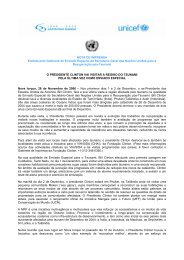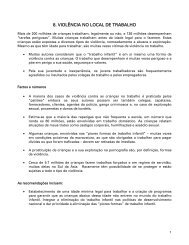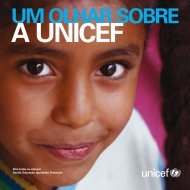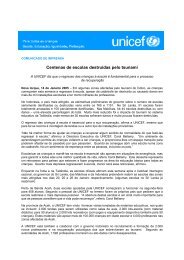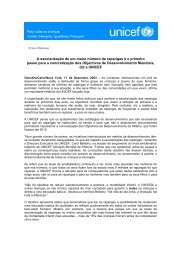Tracking Progress on Child and Maternal Nutrition - Unicef
Tracking Progress on Child and Maternal Nutrition - Unicef
Tracking Progress on Child and Maternal Nutrition - Unicef
Create successful ePaper yourself
Turn your PDF publications into a flip-book with our unique Google optimized e-Paper software.
The relati<strong>on</strong>ship between stunting <strong>and</strong> wealth varies<br />
signifi cantly across countries. In India <strong>and</strong> Nigeria,<br />
children in the richest households are at a distinct advantage<br />
compared to children in other households. This<br />
c<strong>on</strong>trasts with Ethiopia, where stunting is widespread<br />
– even am<strong>on</strong>g children living in the wealthiest households,<br />
the prevalence of stunting is high, at 40 per cent – <strong>and</strong> in<br />
Egypt, where stunting prevalence is remarkably similar<br />
in all wealth quintiles.<br />
<strong>Child</strong>ren in rural areas in the developing world are almost<br />
twice as likely to be underweight as children in urban areas.<br />
Gender <strong>and</strong> social norms<br />
An analysis of nutriti<strong>on</strong> indicators at the global level reveals<br />
negligible differences between boys <strong>and</strong> girls under 5 years<br />
old. Similarly, programme coverage <strong>and</strong> practice data that<br />
are disaggregated by sex reveal no signifi cant differences<br />
<strong>on</strong> the basis of gender. But further disaggregati<strong>on</strong> of data<br />
from some countries indicates there might be differences in<br />
the feeding <strong>and</strong> care of girls compared to boys, presumably<br />
stemming from power relati<strong>on</strong>s <strong>and</strong> social norms that<br />
perpetuate discriminatory attitudes <strong>and</strong> practices. Data in<br />
some countries point to the possible effects, such as<br />
Bangladeshi boys being signifi cantly taller relative to their<br />
age than girls. 36 In sub-Saharan Africa, <strong>on</strong> the other h<strong>and</strong>,<br />
boys are more likely to be stunted than girls. 37<br />
Underweight prevalence, by<br />
gender <strong>and</strong> area of residence<br />
Percentage of children under 5 years old in developing<br />
countries who are moderately or severely underweight,<br />
by gender <strong>and</strong> area of residence<br />
50%<br />
40%<br />
30%<br />
20%<br />
10%<br />
0%<br />
23<br />
Male Female Urban Rural<br />
Note: Estimates are calculated according to the WHO <strong>Child</strong> Growth St<strong>and</strong>ards.<br />
Source: MICS, DHS <strong>and</strong> other nati<strong>on</strong>al surveys, 2003–2008.<br />
36 <str<strong>on</strong>g>Tracking</str<strong>on</strong>g> <str<strong>on</strong>g>Progress</str<strong>on</strong>g> <strong>on</strong> <strong>Child</strong> <strong>and</strong> <strong>Maternal</strong> Nutriti<strong>on</strong><br />
25<br />
16<br />
Gender Residence<br />
29<br />
<strong>Maternal</strong> educati<strong>on</strong><br />
Signifi cant disparity in nutriti<strong>on</strong>al status also exists in terms<br />
of mothers’ educati<strong>on</strong> <strong>and</strong> literacy. A number of studies<br />
<strong>and</strong> analyses have found a signifi cant associati<strong>on</strong> between<br />
low maternal literacy <strong>and</strong> poor nutriti<strong>on</strong> status of young<br />
children. An analysis of survey data from 17 developing<br />
countries, for example, c<strong>on</strong>fi rms a positive associati<strong>on</strong><br />
between maternal educati<strong>on</strong> <strong>and</strong> nutriti<strong>on</strong>al status in<br />
children 3–23 m<strong>on</strong>ths old, although a large part of these<br />
associati<strong>on</strong>s is the result of educati<strong>on</strong>’s str<strong>on</strong>g link to<br />
household ec<strong>on</strong>omics. 38 A study in Pakistan revealed that<br />
the majority of infants with signs of undernutriti<strong>on</strong> had<br />
mothers with virtually no schooling. The study also observed<br />
that the introducti<strong>on</strong> of complementary foods for infants<br />
at an appropriate age (6 m<strong>on</strong>ths) improved when mothers<br />
were educated. 39<br />
Women’s social status<br />
In many developing countries, the low status of women<br />
is c<strong>on</strong>sidered to be <strong>on</strong>e of the primary determinants of<br />
undernutriti<strong>on</strong> across the life cycle. Women’s low status<br />
can result in their own health outcomes being compromised,<br />
which in turn can lead to lower infant birthweight <strong>and</strong> may<br />
affect the quality of infant care <strong>and</strong> nutriti<strong>on</strong>. A study in<br />
India showed that women with higher aut<strong>on</strong>omy (indicated<br />
by access to m<strong>on</strong>ey <strong>and</strong> freedom to choose to go to the<br />
market) were signifi cantly less likely to have a stunted child<br />
when compared with their peers who had less aut<strong>on</strong>omy. 40



